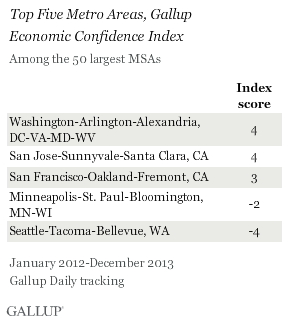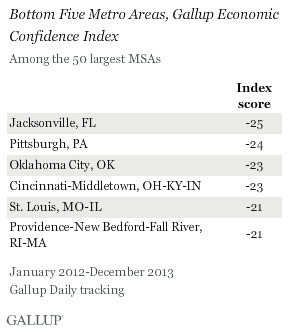WASHINGTON, D.C. -- Among the 50 largest U.S. metropolitan areas, Washington, D.C., remained the most confident in the U.S. economy in 2012-2013, but it now shares the top spot with San Jose, Calif. Both averaged a +4 score on Gallup's Economic Confidence Index over the past two years; they were among the three areas with net positive economic confidence on this measure. Jacksonville, Fla., had the lowest economic confidence (-25).


These results are based on Gallup Daily tracking conducted throughout 2012-2013 in the 50 most populous U.S. metropolitan statistical areas (MSAs). Gallup interviewed at least 12,000 adults in each of these MSAs, with the highest number of interviews, 15,443, conducted in the New York City metro area. Each MSA sample is weighted to match the demographic characteristics of that area. Results for all 50 MSAs can be found on page 2.
Gallup's Economic Confidence Index is a composite of Americans' ratings of current U.S. economic confidence conditions and their perceptions of the economy's direction. The index has a theoretical maximum of +100 (if all respondents rate the economy as "excellent" or "good" and say it is getting better), and a theoretical minimum of -100 (if all rate the economy as "poor" and say it is getting worse). Nationwide, the Gallup Economic Confidence Index averaged -16 in 2013.
Washington, D.C., had a -5 score for the economic conditions component, but its +13 score for economic optimism boosted its overall index reading to positive territory, putting it ahead of the other metro areas. San Jose, too, had a negative score for the economic conditions component (-8), but was buoyed by its positive readings for optimism (+16), which brought its index to the top of the list.
Jacksonville had a dismal economic outlook score (-21), but an even more dismal score for current conditions (-28), which sank the MSA to the very bottom of the list. Pittsburgh, coming in second-lowest in overall confidence, had a -26 economic outlook score and a -23 score for current economic conditions.
Bottom Line
Though economic confidence is still negative in most MSAs, most areas saw slight increases when factoring in the 2013 data. And fortunately for areas near the bottom such as Jacksonville and Pittsburgh, MSA confidence levels have shown some resilience. Buffalo, N.Y., for example, whose dismal confidence readings put it at the bottom in 2011, has climbed to the relatively average reading of -18 for 2012-2013.
Survey Methods
Results are based on telephone interviews conducted as a part of Gallup Daily tracking Jan. 1, 2012-Dec. 3, 2013, with a random sample of 164,754 adults, aged 18 and older, living in the 50 largest metropolitan statistical areas (MSAs) by population.
Margins of error for individual MSAs are no greater than ±4 percentage points and are ±3 percentage points in most MSAs.
Interviews are conducted with respondents on landline telephones and cellular phones, with interviews conducted in Spanish for respondents who are primarily Spanish-speaking. Each sample of national adults includes a minimum quota of 50% cellphone respondents and 50% landline respondents, with additional minimum quotas by time zone within region. Landline and cellular telephone numbers are selected using random-digit-dial methods. Landline respondents are chosen at random within each household on the basis of which member had the most recent birthday.
Samples are weighted to correct for unequal selection probability, nonresponse, and double coverage of landline and cell users in the two sampling frames. They are also weighted to match the national demographics of gender, age, race, Hispanic ethnicity, education, region, population density, and phone status (cellphone only/landline only/both, and cellphone mostly). Demographic weighting targets are based on the most recent Current Population Survey figures for the aged 18 and older U.S. population. Phone status targets are based on the most recent National Health Interview Survey. Population density targets are based on the most recent U.S. census. All reported margins of sampling error include the computed design effects for weighting.
In addition to sampling error, question wording and practical difficulties in conducting surveys can introduce error or bias into the findings of public opinion polls.
For more details on Gallup's polling methodology, visit www.gallup.com.

